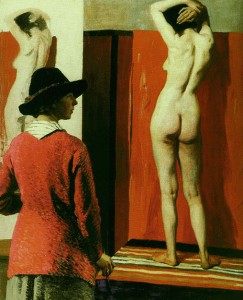Beginning my tour of the National Portrait Gallery in the room of Tudor paintings, I immediately noted the types of people included in the gallery’s selection of portraits: British royalty and aristocrats. As I wove my way in and out of the various rooms and hidden side rooms, I continued to notice a broader representation of the English classes. This included notable figures of military, political, and scientific importance, as well as remarkable social reformers, explorers, poets and writers, painters and sculptors, composers and musicians, and actors. Some scenes of war and exploration–or imperialism, if you prefer to describe it as such–were additionally included in the gallery. I therefore came to the conclusion that clearly, the National Portrait Gallery really wasn’t a proper representation of all English people. There were no people of lower classes–those without distinctive historical achievements.
It wasn’t until the last galleries I explored, the contemporary portraits and portrait finalists, that I noticed another distinctive exclusion: portraits of non-white English people. I unfortunately didn’t keep an exact count of the portraits depicting any English immigrants, but they most certainly were a minority. I found this ironic, as the National Portrait Gallery cannot accurately be called “national” when countless English people are excluded from the paintings–everyday people and immigrants of other ethnic backgrounds.
The National Portrait Gallery does not share this image on its website, so I found it here.
The portrait I chose in the National Portrait Gallery is “Self with Nude,” painted by Dame Laura Knight in 1913. This painting, illustrated above, is of a woman, the artist Laura Knight, painting a portrait of a nude female model. I found it striking as it was displayed in a large alcove, and its provocative nature most definitely caught my eye as it hung amongst other smaller, less distinctive portraits. Dame Laura Knight was an Official War Artist during the Great War (WWI) and recorded the famous Nuremberg Trials after WWII. In regards to this particular portrait though, it represents Knight’s prominence as a talented female painter defending the right for women to paint from a nude life model. The painting was placed in the gallery titled “We are making a New World Britain 1914-1918” where the gallery’s description stated that the Great War was an “end to an era, but it was also a catalyst for changes.”


2 responses so far ↓
Karl // Sep 3rd 2010 at 16:04
The painting certainly speaks of a new era. Good choice. Make sure to credit the gallery’s web site for the reproduction in your blog
jamie // Sep 6th 2010 at 17:56
I definitely like your choice Mary. I didn’t even see this portrait. I wonder, however, do you think that if the nude subject of Dame Laura Knight’s portrait had been a male would it still be on display in the National Portrait Gallery?
You must log in to post a comment.